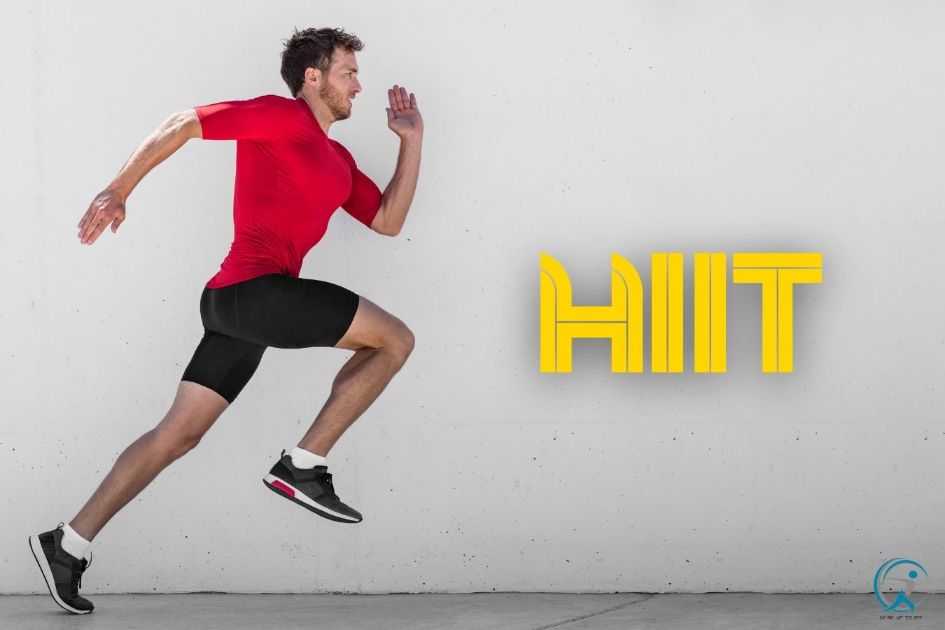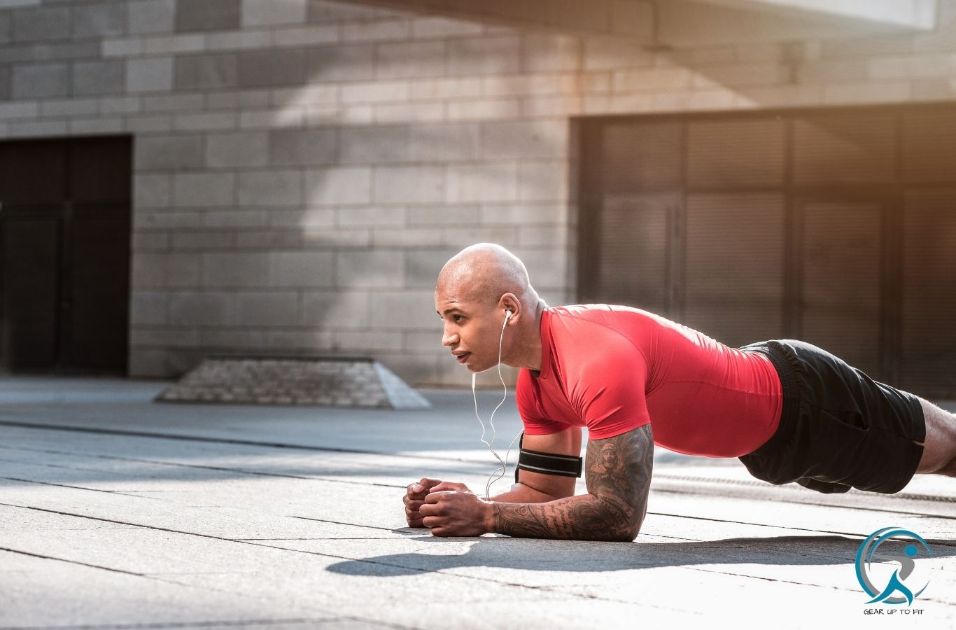HIIT is an intense form of exercise that has been gaining popularity over the past few years. But is it really beneficial, or is HIIT bad for you?
HIIT has been getting a lot of hype lately as the most effective way to burn fat and lose weight fast, but as with any exercise, there are some downsides to HIIT that you should be aware of before you start using it your only form of exercise. Luckily, these downsides are pretty easy to avoid if you know about them beforehand, so let’s look at them now!
Key Takeaways
- HIIT workouts can be safe and beneficial for most people if done correctly.
- Warm-up and cool-down routines are important to prevent injuries during HIIT workouts.
- Individuals with certain health conditions should consult a healthcare professional before attempting HIIT.
- HIIT can improve cardiovascular health, boost metabolism, and burn calories quickly.
- Combining HIIT with other exercises creates a well-rounded fitness routine.
- Consistency is key for seeing results from HIIT workouts.
The Downsides of HIIT
When you do a lot of high-intensity exercise in a short period, you’re putting stress on your body. This is good because it can increase your cardio capacity, but it also has some downsides that you should be aware of.
One of these downsides is that it can increase your risk of injury. When you push yourself beyond what’s comfortable, you’ll be more likely to injure yourself while exercising.
Another downside of high-intensity interval training is that it can interfere with your endurance if you make it a regular part of your workouts. When you’re putting your body through all that stress, it’s hard to recover from day to day.
That said, high-intensity interval training does have some valuable benefits. It can help you burn more calories than steady-state exercise. It can also be less stressful on your body if you’re only doing it occasionally. It’s just important to keep these downsides in mind if you’re considering adding high-intensity interval training to your workout regimen.
To be clear, high-intensity interval training is not bad for you; it’s just something that can have some adverse effects if you overdo it. If you only want to do high-intensity interval training occasionally, that’s fine.
But if you want to regularly add high-intensity interval training to your workout routine, it’s a good idea to start with shorter workouts and slowly work your way up. You can also space them out if you do one or two weekly high-intensity interval training sessions. That way, your body will have time to recover in between. The goal is to reduce your risk of injury as much as possible.
Too Much of a Good Thing

While there’s no question that high-intensity interval training (HIIT) is an excellent way to lose weight and burn calories quickly, it also comes with some downsides. If you decide to begin incorporating HIIT into your routine, there are a few downsides you should know about and avoid at all costs.
Too much high-intensity interval training is bad because it can lead to overtraining, which results in burnout and missed workouts. Working out too intensely and for too long can also make you more susceptible to illness and injury. Furthermore, regularly working out isn’t healthy; your body needs rest days to repair muscle damage and strengthen your cardiovascular system. Take at least one rest day per week as a general rule.
Do you need to take a rest day or two every week if you’re planning on incorporating high-intensity interval training into your routine? Absolutely! As long as you avoid these downsides and listen to your body, you can reap all of high-intensity interval training’s benefits without feeling like it’s bad for you.
Also, don’t forget that high-intensity interval training won’t help you build much muscle, but it will help you lose weight and improve your cardiovascular endurance. If you want to add more muscle definition to your body, you’ll need to incorporate strength training into your routine too. That being said, high-intensity interval training is an excellent way to get in shape quickly—especially if you lack time for more traditional forms of exercise!
To sum it up, high-intensity interval training is an effective way to lose weight, increase your cardiovascular endurance, and gain muscle definition. Remember that if you want to experience all of its benefits, you should avoid working out too intensely, for too long, or on consecutive days.
What happens when you do too much HIIT

When you do too much high-intensity interval training (HIIT), your body will burn through all of its glycogen stores. When that happens, your body can use fat as a fuel source. But because you’re working out so hard, your glycogen stores might take a day or two to fill up again. Once you do, you’ll find that fat has become your go-to energy source because carbs are in short supply.
While too much HIIT is bad, it isn’t dangerous. Although you’ll need to cut back on your workout intensity if you do too much and burn through all your glycogen stores, that’s not irreversible. Your glycogen levels will be more stable before your next workout if you do moderate steady-state cardio.
The real danger with too much HIIT is that it can lead to injuries. Because you’re working out so intensely, your body is prone to get hurt. If you work out without proper rest and recovery or without stretching properly before and after workouts, then you’re putting yourself at risk of sprains, strains, and even muscle tears.
Additionally, your risk of injury increases if you increase your workout frequency. Doing more than two weekly workouts can lead to overuse injuries, especially if you don’t allow your body to recover between sessions.
Additional potential downsides of HIIT
- Overtraining: Doing too much HIIT too often can lead to overtraining, which can cause fatigue, decreased performance, and an increased risk of injury. It’s important to listen to your body and take rest days when needed.
- Increased risk of injury: Because HIIT involves high-intensity movements and can be challenging for the body, there is an increased risk of injury. It’s important to use proper form, warm up before exercising, and stretch afterward to prevent injury.
- Not suitable for all fitness levels: HIIT may not be suitable for everyone, especially those who are new to exercise or have underlying health conditions. It’s important to start slowly and work up to more intense workouts as you build strength and endurance.
- Muscle soreness: HIIT can cause muscle soreness, especially for beginners or those new to this type of training. This is normal, but it’s important to rest and recover properly to prevent further injury or strain.
- Potential hormonal imbalances: HIIT can impact hormonal balance, particularly for women, and may cause irregular menstrual cycles or other hormonal imbalances.
How often should you do HIIT?

The real downside of HIIT is that it’s addictive. If you push yourself to your limits every time, or if you only do high-intensity workouts a few times a week, you could end up overtraining and burnout faster than you can say water break. Even worse, when you perform too much intense exercise without proper recovery time in between sessions, your adrenal glands release excess cortisol—the stress hormone that promotes belly fat storage—and testosterone levels plummet.
A good rule of thumb is to do no more than 20 minutes of high-intensity exercise a day, three days a week. To reap these benefits and stay safe, stick to workouts that last no longer than 10 minutes. This gives your body a chance to rest and recover in between sessions so you don’t overdo it—and possibly injure yourself. Plus, at that length, you can still get an effective workout before or after your morning commute.
While there are benefits to short and intense exercise, some people take that advice too far. High-intensity interval training (HIIT) is a form of exercise that alternates short bursts of high-intensity anaerobic exercise with low-intensity recovery periods. While HIIT can provide many benefits, such as improved insulin sensitivity and increased aerobic fitness, overdoing it can lead to injuries like sprains and strains and stress fractures.
Finding the Right Balance

Since high-intensity interval training is a relatively new way to work out, no major studies have looked at how it affects health in the long run. However, most people know that working out too much can be just as bad as not working out enough—if you push yourself too hard, you might experience overexertion, which can lead to injury or illness in extreme cases. The same can be said of HIIT.
The same thing goes for HIIT. If you push yourself too hard, you could experience overexertion, resulting in injury or illness. To avoid overexertion, it’s best to start with a lower-intensity form of exercise (such as walking) and slowly work your way up to more vigorous activity over time.
Also, it would be best if you didn’t do more than two weekly high-intensity interval training workouts.
As with any other form of exercise, it is best to begin with a low-intensity workout (such as walking) and gradually work up to more vigorous activity over time. For example, if you’re beginning a walking program, aim to walk 20 minutes daily. After two weeks, add five minutes daily until you’re up to an hour of daily walking.
If you’re in good shape and have a solid fitness foundation, you can more frequently participate in high-intensity interval training workouts. However, if you’re beginning an exercise program or not very active, aim to work out no more than twice per week.
While you may be worried about spending too much time exercising or training, it’s important to note that overexertion can be harmful. You could experience fatigue, muscle soreness, and injury if you push yourself too hard.
At-Home Alternatives
If high-intensity interval training isn’t for you—whether due to physical limitations or personal preference—there are still plenty of ways to incorporate exercise into your daily routine.
If you’re interested in high-intensity interval training but don’t have time to get to a gym, plenty of at-home alternatives exist. For example, if you run on a treadmill, try running outdoors instead. If you do strength training once weekly, try adding a yoga or Pilates class to your workout routine.
Maximizing the Benefits and Minimizing the Risks of High-Intensity Interval Training (HIIT)
To maximize the benefits of HIIT while minimizing the potential risks, it’s essential to:
- Start slowly and gradually build up intensity and duration over time.
- Incorporate rest and recovery days into your workout routine to prevent overtraining and injury.
- Use proper form and technique to prevent injury.
- Warm up before exercising and stretch afterward to prevent muscle soreness and injury.
- Consider working with a certified personal trainer or fitness professional to ensure you’re using the proper technique and form.
- Pay attention to your body and adjust your workout routine to prevent injury and promote overall health.
By following these tips and being mindful of the potential risks and benefits of HIIT, you can safely and effectively incorporate this type of training into your fitness routine.
Understanding the Impact of HIIT
High-Intensity Interval Training (HIIT) is a powerful workout regimen known for its efficiency in improving cardiovascular health and promoting fat loss. However, the question arises, “Is HIIT bad for you?” Like any exercise, HIIT comes with its own set of advantages and disadvantages. It involves cycles of high-intensity exercises followed by short rest periods, pushing the body’s limits, which can be both beneficial and challenging.
Balancing Intensity to Avoid Overtraining
HIIT’s intense nature necessitates a careful approach to avoid overtraining and potential injuries. Overdoing HIIT can lead to exhaustion, muscle strains, and other physical setbacks. It’s crucial to listen to your body, ensuring that you’re not pushing beyond your capacity. Incorporating adequate rest days and ensuring proper form during exercises are essential practices to minimize risks associated with HIIT.
Customizing HIIT for Individual Needs
HIIT is not a one-size-fits-all solution. Its suitability can vary based on individual fitness levels and health considerations. Customizing HIIT workouts to align with personal health status and fitness goals is essential. For beginners or those with specific health conditions, a moderated and well-supervised approach to HIIT is advisable to ensure that the exercises are conducted safely and effectively.
The Comprehensive Approach to HIIT
While HIIT is potent, it should not be the sole focus of a fitness regimen. Combining HIIT with other forms of exercise such as strength training and flexibility exercises can offer a more comprehensive fitness approach. This combination can help in achieving a balance, preventing overemphasis on high intensity, and promoting a well-rounded fitness outcome.
FAQs
1. Is HIIT suitable for beginners? Yes, but start slowly and consult a professional to ensure proper form and avoid injuries.
2. Can HIIT help with weight loss? Absolutely! HIIT increases metabolism and burns calories even after the workout.
3. Is HIIT suitable for older adults? Yes, but modifications may be needed. Consult a healthcare professional for personalized advice.
4. How often should I do HIIT workouts? 2-3 times per week is recommended to allow for proper recovery and avoid overtraining.
5. Are there any risks associated with HIIT? While generally safe, improper form and overtraining can increase the risk of injury.
Conclusion
In conclusion, the question “Is HIIT bad for you?” does not have a straightforward answer. While HIIT can provide numerous benefits such as improved cardiovascular health and increased fat loss, it can also lead to injuries if not performed correctly. Understanding your body’s limitations and gradually increasing the intensity and duration of your HIIT workouts is crucial.
Additionally, it is essential to consult a healthcare professional before starting any new exercise regimen, especially if you have any pre-existing medical conditions. With the right guidance and approach, HIIT can be a safe and effective form of exercise for many individuals.
References
Trapp, E. G., Chisholm, D. J., Freund, J., & Boutcher, S. H. (2008). The effects of high-intensity intermittent exercise training on fat loss and fasting insulin levels of young women. International Journal of Obesity, 32(4), 684-691. https://www.nature.com/articles/0803781
Macpherson, R. E., Hazell, T. J., Olver, T. D., Paterson, D. H., & Lemon, P. W. (2011). Run sprint interval training improves aerobic performance but not maximal cardiac output. Medicine and Science in Sports and Exercise, 43(1), 115-122. https://journals.lww.com/acsm-msse/Fulltext/2011/01000/Run_Sprint_Interval_Training_Improves_Aerobic.15.aspx
Kraemer, W. J., Ratamess, N. A., & French, D. N. (2002). Resistance training for health and performance. Current Sports Medicine Reports, 1(3), 165-171. https://journals.lww.com/acsm-csmr/Fulltext/2002/06000/Resistance_Training_for_Health_and_Performance.7.aspx
Gist, N. H., Fedewa, M. V., Dishman, R. K., & Cureton, K. J. (2014). Sprint interval training effects on aerobic capacity: a systematic review and meta-analysis. Sports Medicine, 44(2), 269-279. https://link.springer.com/article/10.1007/s40279-013-0115-0
Klika, B., & Jordan, C. (2013). High-intensity circuit training using body weight: Maximum results with minimal investment. ACSM’s Health & Fitness Journal, 17(3), 8-13. https://journals.lww.com/acsm-healthfitness/Fulltext/2013/05000/High_Intensity_Circuit_Training_Using_Body_Weight_.5.aspx
Brzycki, M. (1993). Strength testing—predicting a one-rep max from reps-to-fatigue. Journal of Physical Education, Recreation & Dance, 64(1), 88-90. https://www.tandfonline.com/doi/abs/10.1080/07303084.1993.10606684
Helgerud, J., Høydal, K., Wang, E., Karlsen, T., Berg, P., Bjerkaas, M., & Hoff, J. (2007). Aerobic high-intensity intervals improve VO2max more than moderate training. Medicine and Science in Sports and Exercise, 39(4), 665-671. https://journals.lww.com/acsm-msse/Fulltext/2007/04000/Aerobic_High_Intensity_Intervals_Improve_VO2max.12.aspx
Karlsen, T., Aamot, I. L., Haykowsky, M., Rognmo, Ø., & Støylen, A. (2017). High-intensity interval training for maximizing health outcomes. Progress in Cardiovascular Diseases, 60(1), 67-77. https://www.sciencedirect.com/science/article/pii/S0033062016302916
As a veteran fitness technology innovator and the founder of GearUpToFit.com, Alex Papaioannou stands at the intersection of health science and artificial intelligence. With over a decade of specialized experience in digital wellness solutions, he’s transforming how people approach their fitness journey through data-driven methodologies.
